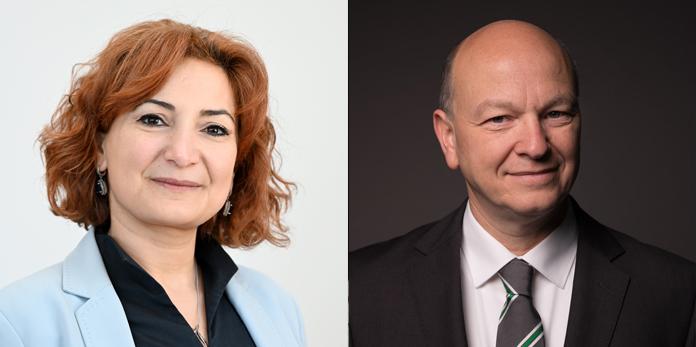Meet the CCRI stakeholders: Southeast Lower Saxony (CCRI Fellow)
Published on 27.03.2025
This month, we spoke to Professor Ani Melkonyan-Gottschalk and Professor Daniel Goldmann to discuss the circular economy in Southeast Lower Saxony, Germany.
Professor Goldmann is developing recycling systems with a circular technology transfer approach, while Professor Melkonyan-Gottschalk is a specialist in sustainability with a focus on sustainable supply chains and logistics, industrial ecosystems and circular regions.
Ani and Daniel tell us about how the region has benefited from knowledge exchange and collaboration through the CCRI. We also discuss how the region has set out to achieve closed-chain battery production, reused critical raw materials in the construction industry, and reduced CO₂ in steel production through collaboration with the agricultural industry.

Southeast Lower Saxony CCRI has identified key circular topics such as CO₂-reduced steel production, circular battery production, and urban mining. Could you tell us about initiatives in these areas?
Daniel: Since our region has been a mining, raw materials and recycling region for a very long time, our goal is now to head towards a circular society with circular production ecosystems. We are cooperating with companies and research organisations on topics such as closed-chain battery production. Now, we are changing from technological transfer to societal transformation.
Ani: Soon we will have a new government, which plans to invest EUR 500 billion into infrastructure. Steel plays a crucial role in physical infrastructure, but we also expect increased needs for efficient logistics and digital infrastructure. We are therefore also addressing supply chain integration along regions, for which logistics is an enabling player.
Daniel: With respect to circular battery production, in our region we work with companies like Volkswagen to close the material loop through battery reuse and recycling. At first, start-up companies at the front end of the processing chain were established, as well as companies producing black mass [the active powder in batteries]. We hope that a hydrometallurgical plant will be built in near future so we can close the regions’ production loop.
On CO₂-reduced steel production, the second-largest steel producer in Germany has changed from carbon to hydrogen-based production. This is not as simple as generating steel from iron or replacing coke with hydrogen: you need a bio-based gas or bio-based coal, which requires cooperation with agricultural partners.
Ani: In the steel sector, we work on cross-disciplinary aspects, addressing heavy-industry. But we also work with the food sector. As Daniel said, hydrogen-based steel production involves agriculture, for which we have initiatives in our region.
Daniel: On urban mining and recycling building materials, all processes have waste streams that we can recapture and bring back into building structures to achieve a closed loop in the sector.
If we start to build, we need critical raw materials like concrete, sand and cement. Therefore, we must close the material loops, because the primary raw materials will not be sufficient to run the whole system. We connect players that have never worked together, which is challenging, but we have an advantage as we have a more-or-less closed chain of actors in our region.
Given the diverse stakeholders involved, how do you collaborate to promote the circular economy in Southeast Lower Saxony?
Daniel: Our region has companies in many fields, some of which are world leaders who have changed their production model from primary raw materials to recycled materials in the last decade.
In 2011, we founded our recycling cluster for critical metals, REWIMET, which has expanded and now recycles more than just metal. This group comprises over 25 companies, local authorities and research organisations cooperating to close the critical raw material loops. It helps us to ensure the availability of raw materials through recycling, supporting our regional industrial symbiosis projects because it brings together the different circular actors and structures their actions.
Ani: Besides working with industrial clusters like REWIMET, we also engage with policy, academia, media and citizen science to better understand the interaction between production and consumption systems. Involving all stakeholders makes the industrial ecosystem more resilient and sustainable.
Last autumn, the government of Lower Saxony established its ninth commission on ‘Circular Economy’. I am leading one of the four groups, named ‘Circular Society’ in which we cooperate with ministries, NGOs, labour organisations and industries from various sectors to cover the needs for the efficient socio-technical transformation of society.
Regional circular transformation needs the right political levers and frameworks. Thus, our multidisciplinary Circular Society group brings together various perspectives, aiming at developing political recommendations to set the agenda of transformation with the right levers.
Our close collaboration with the Ministry of Environmental Protection of Lower Saxony has also been a great success. Through the Ministry’s funding, we have established a circularity hub project to build up synergies with other activities in the region, and in Germany.
As a Fellow region in the CCRI community, how has Southeast Lower Saxony benefited from knowledge exchange, collaboration, and best practices shared within the initiative?
Daniel: We try to cooperate with other circular regions in Europe; currently we are in contact with Scotland and Spain. From our side, this is what participating in the CCRI brings; if we have competencies that complement each other, this will help us and everyone else to develop a European circular society.
Ani: Beyond national networking strategies, we aim to bundle our efforts with other CCRI projects. I attended the third CCRI Coordination and Support Workshop in Brussels in November last year, where I met many interesting stakeholder groups from CCRI regions.
Two of these regions are from Finland (Tampere region and Päijat-Häme region) and are currently developing a database tool, bringing together various regional competences from CCRI regions and mapping their circular activities.
With them, we are aiming to apply for an upcoming programme for a European green deal for circular regions and are eager to collaborate with other regions to enhance the circularity agenda of the EU.




